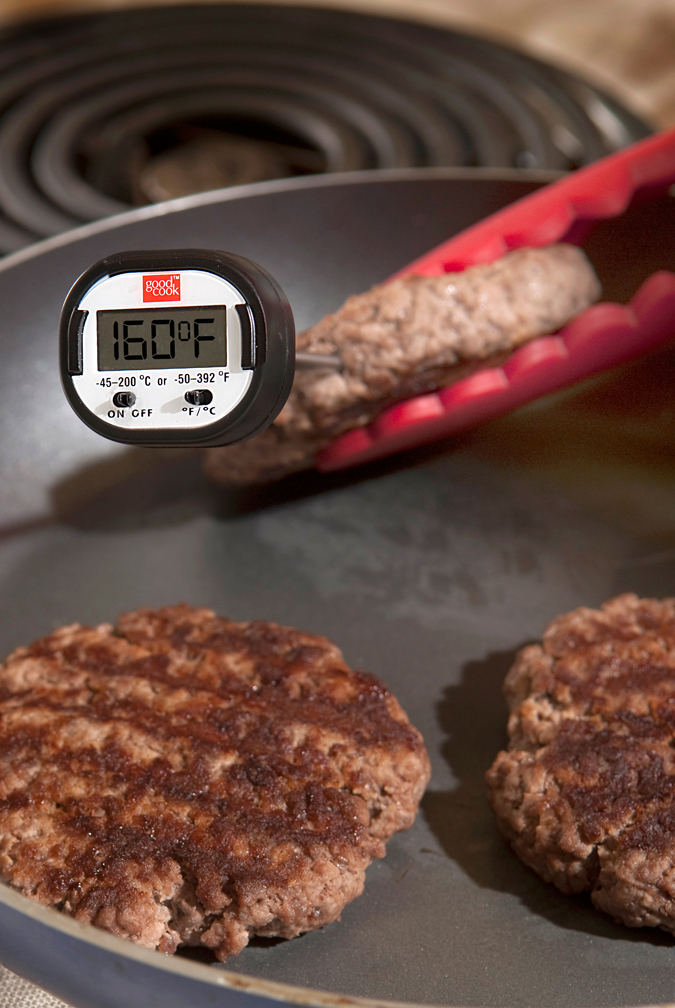Key to Knowing When Meat is Done is a Food Thermometer
TEXARKANA, Ark. –
With Memorial Day coming up Monday, many will be outside grilling. It’s great to be able to be outside and get some fresh air, but we still must practice food safety.
Many of us will be grilling meat. Using a meat thermometer will help assure that the meat is cooked properly.
Food thermometers are for all cuts and sizes of meat, fish, and poultry, including hamburgers, chicken breasts, and pork chops. Using a food thermometer when cooking meat, poultry and even egg dishes is the only reliable way to ensure you are preparing food safely.
Many say, “I can tell if my hamburger is done by looking at it.” Are you sure? USDA research shows that one in four hamburgers turn brown before they reach a safe internal temperature. This means that they may look done, but not be cooked to the appropriate temperature, which can set you and your family up for a possible case of food borne illness.
Not only does a food thermometer allow you to safely cook to a safe internal temperature, it also prevents you from overcooking the product and takes the guesswork out. Food will be juicy and flavorful, not undercooked or dry and tasteless.
Food thermometers are inexpensive and readily available at local discount stores. Plus, they are easy to use. Because there are so many types of food thermometers, it is important to follow the instructions for your food thermometer, plus follow these tips:
- Use an instant read thermometer to check the internal temperature toward the end of the cooking time, but before the food is expected to be ‘done”.
- Insert the food thermometer into the thickest part of the food, making sure it doesn’t touch bone, fat or gristle. On the stem will be a dimple. It must be inserted past the dimple to get an accurate reading.
- Cook food until the thermometer shows an internal temperature of 160° for ground meats, 165 for ground poultry, 145° for Beef, Pork, Veal & Lamb including steaks, chops, roasts; 165° for chicken breasts and whole poultry.
- Lastly, make sure to clean your food thermometer with hot, soapy water before and after each use. Do not place in the dishwasher.
If you would like to receive a free “Is It Done Yet?” temperature chart or brochure with more detailed information on using food thermometers, contact the Miller County Extension Office, 870-779-3609. We're online at cdue@uada.edu, on Facebook and Twitter @MillerCountyFCS or on the web at uaex.uada.edu/Miller.
Experiment with your food thermometer with this recipe for Grilled Fiesta Burgers. This recipe makes 4 servings.
Grilled Fiesta Burgers
1 1/2 pound ground beef
1/4 cup onion, chopped
2 tablespoons red bell pepper, finely chopped
3 tablespoons picante sauce or salsa
2 teaspoons prepared Dijon-style mustard
1 tablespoon prepared horseradish (optional)
Salt and pepper to taste
4 whole-wheat hamburger buns
Condiments such as leaf lettuce, sliced tomatoes, jalapenos, onion, pickles, etc.
In a bowl, mix all ingredients except hamburger buns and condiments. Form four burgers, about three-fourths inch thick. Using utensils, place burgers on grill that has reached medium-high heat. Check each burger with a food thermometer, by inserting it horizontally in the side past the dimple. Turn burgers as needed. Do not smash burgers when turning. It will be done at 160°F. Place burgers on buns and top with condiments of choice.
By Carla Due
County Extension Agent - FCS
The Cooperative Extension Service
U of A System Division of Agriculture
Media Contact: Carla Due
County Extension Agent - FCS
U of A Division of Agriculture
Cooperative Extension Service
400 Laurel Street, Suite 215 Texarkana AR 71854
(870) 779-3609
cdue@uada.edu
Related Links
The Arkansas Cooperative Extension Service is an equal opportunity institution. If
you require a reasonable accommodation to participate or need materials in another
format, please contact your County Extension office (or other appropriate office)
as soon as possible. Dial 711 for Arkansas Relay.
Pursuant to 7 CFR § 15.3, the University of Arkansas System Division of Agriculture
offers all its Extension and Research programs and services (including employment)
without regard to race, color, sex, national origin, religion, age, disability, marital
or veteran status, genetic information, sexual preference, pregnancy or any other
legally protected status, and is an equal opportunity institution.
